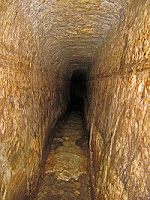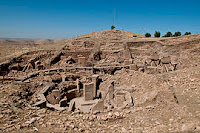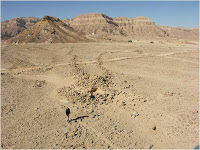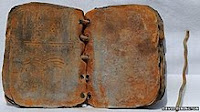Obviously the view of many scholars is in stark contrast to the biblical narrative. So which is correct? Was David just a myth, a powerful king, or something in between? What does the archaeological evidence tell us about David? Is there any physical evidence that says David was a living breathing person, and perhaps the king of a powerful and influential kingdom? In this post we will look at four pieces of evidence that say David was indeed real, and very likely a powerful king.
King David’s Palace in
Jerusalem
In 2005 Archaeologist Eilat Mazar began excavations a few hundred feet south of the temple mount. While the area had been previously excavated, Mazar was looking for something she believed the original archeologist had missed, or simply had not recognized. As the excavation progressed Mazar's team slowly unearthed a stone structure. The structure was large, complex, and was believed to be a temple or palace of some type. Mazar points out a temple would have been redundant since there were plans to build a temple on the site where Abraham almost sacrificed his son Isaac (The Temple Mount). She believes the structure is instead a palace and furthermore she believes it belonged to King David. According to Mazar the structure is perfectly located to match the location and description given in the Bible. Mazar's group has dated the site to the 10th or 11th century B.C. exactly when the Bible tells us David was in power.
“Now Hiram king of Tyre sent
envoys to David, along with cedar logs and carpenters and stonemasons, and they
built a palace for David.” 2 Samual 5:11
“Now Hiram king of Tyre sent
messengers to David, along with cedar logs, stonemasons and carpenters to build
a palace for him.” 1 Chronicles 14:1
“After David was settled in his palace, he said to Nathan the prophet, “Here I am, living in a house of cedar, while the ark of the covenant of the Lord is under a tent.” - 1 Chronicles 17:1
(Note: Although Mazar dates the foundation and building to the 10th or 11th century B.C. this is not universally accepted. Other scholars want to further study the area before accepting Mazar's dating. There are also questions relating to the structure itself. Some believe the site is actual more than one structure and not a single large palace as Mazar suggests. At the time of this writing Mazar was continuing her excavations but three occupied homes sit atop the area she and others most want to explore.)
Stepped Stone Structure
One of the most famous structures in the City of David is the
Stepped Stone Structure. The structure is sixty feet tall and has been dated to
1000 B.C.. Among leading
archaeologists Nadav Na’aman and Elit Mazar both believe the records and
archaeological evidence indicate the Stepped Stone Structure is a part of King
David’s palace, or is in some way related to the palace.
The structure was first excavated in the 1920’s and was built over a series of terraces. Interestingly there is a four-room house at the base of the structure known as the House of Ahi’el. The upper section of the structure joins a wall which could have been an original retaining wall for King David’s Palace.
The structure was also joined by several nice homes built by Jerusalem’s elite and royalties. The structure is large, properly located, associated with other Royal homes and is from the correct time period. While no actual inscriptions naming this as belonging to King David have been found, the evidence, and many leading archaeologist, believe this is indeed associated with the King of Israel.
King David’s Citadel
This is a slightly older discovery with a new
interpretation which may offer even more proof of David and his expansive
kingdom. Reports have been coming out of Jerusalem concerning the discovery of
King David’s Citadel. The Citadel is recorded in the book of 2 Samuel 5:6-9 as
the entry point for the forces under David’s command when he attacked the city
of Jerusalem. Eli Shukron, an archaeologist formerly with the Israel
Antiquities Authority (IAA), believes the archaeological excavations in question
are the location mentioned in the Bible. As it seems with any claims
associated with King David, Shukron’s theories have been met with considerable
skepticism.
The king and his men marched to Jerusalem to
attack the Jebusites, who lived there. The Jebusites said to David, “You will
not get in here; even the blind and the lame can ward you off.” They thought,
“David cannot get in here.” 7 Nevertheless, David captured the fortress of
Zion—which is the City of David.
8 On that day David had said, “Anyone who conquers
the Jebusites will have to use the water shaft to reach those ‘lame and blind’
who are David’s enemies.” That is why they say, “The ‘blind and lame’ will not
enter the palace.”
9 David then took up residence in the fortress and called it the City of David. He built up the area around it, from the terraces inward. - 2 Samuel 5:6-9
The excavations have uncovered a set of parallel
walls as well as a tower next to a pool and a second massive tower which was
positioned to protect the Gihon Spring. Some of these walls were constructed
using five-ton stones stacked as much as twenty-one feet across. These
excavations, overseen by Shukron and his partner Ronny Reich, are not new. In
fact, the excavations at this site began almost 15 years ago and were concluded
2 years ago. So the site is well known and the dates for the walls and towers do
not seem to be in question. Most scholars agree the fortifications were built
in the late 18th century B.C.
While the date of construction for the walls and towers is almost universally accepted, there is some debate caused by the lack of pottery shards from the 10th century B.C. Pottery is widely used to help date an archaeological site and is generally very accurate. In this case Shukron and Reich found very little 10th century pottery in their excavations, which is a point of concern for some. Reich believes the lack of pottery shards from the 10th century B.C. raises some doubts as to if the fortifications were in use at that time. As Shukron points out, the 10th century pottery shards would probably have been removed by the occupants since he believes the fortifications were in continuous use from the time of their construction until well after King David entered the city. A large number of pottery shards were discovered from approximately 100 years after the time of King David. This seems to match Shukron’s theory very well. Confidence in this time-line is not shared by all archaeologists and is the primary area of controversy regarding Shukron’s theories. This however, is not the only area of contention.
Other archaeologists believe the citadel was in use in the 10th century B.C. but are not totally convinced it is the same fortifications mentioned in the Bible. While Shukron claims the site matches the Bible’s description perfectly and is the only possible match in the City of David, others are hesitant. The fortifications did guard the city’s water supply and there was a tunnel discovered through which excess water would have flowed out of the city. It is believed it was this tunnel which David’s men used to gain access to the heavily fortified city. On the surface the area and time-line seem to match the Biblical narrative, and while archaeologists such as Reich are willing to agree this is a significant discovery, they are not fully ready to associate it with the Biblical narrative.
Inscription Mentions King DavidAs mentioned, many claimed David was only a myth, more of a symbol than an actual person and certainly not a ruler of any significant kingdom. The kingdom, if it existed at all in 10th century B.C., has been described by critics as dusty backwoods cross roads made up of nomads living in tents.
This opinion began to shift in the mid-1990's
after Doctor Avraham Biran's team discovered an inscribed stone while
excavating at Tel Dan. The group was preparing the site for visitors when they
discovered the stone fragment in a wall. It was obvious the stone was in
secondary use and had not originally been intended for use in the wall. Two
more pieces of the broken stone were found in the same area and the inscription
began to take shape. While more than a third of the original stone has never
been found, the inscription on the stone pieces discovered revealed some
remarkable and historic information.
The inscription mentions Hadad, Jehoram, Ahab
and the House of David. It also speaks of riots, thousands of horsemen, and
laying siege. While the age of the stone is uncertain, because of the area in
which it was found experts know it could not have been placed there prior to
732 B.C. It was also clear the stone had been intended as a testament to
significant events, most probably a military victory. It is believed when
political changes took place the new leaders did not want to be reminded of
these events and had the stone broken, or so it is theorized. Regardless, it
seems quite certain the stone was inscribed well before 732 B.C.
Although the entire stone has not been
recovered, and its exact origin is uncertain, the inscriptions give us solid
proof David was a real person and apparently a ruler since the stone refers to
the 'House of David'. The inscription, as compelling and convincing as it may be, is not forced to stand alone as a written record of David.
It may come as a surprise to many, but this
mention of David may not be the only inscription to note the great king. It is
certainly the most accepted, but it could be just one of three that have been
discovered to date. On another artifact, “The Meshe Stele”, a number of scholars believe a lower portion of the inscription reads “…in
it dwelt the house of David…”. This inscription was found a full year
before the Tel Dan Inscription was discovered.
Unfortunately, a portion of the inscription is
considered questionable by many. The ‘D’ in David is distorted and some dispute
it being read as David. The argument continues between the two groups but those
who argue for it being David point out there is very little else it could be.
There is yet another potential inscription which
mentions King David. This one is in Egypt and lists a series of military
campaigns. The inscription is just a portion of a long lists on a wall in Karnak.
The line in question has been translated by some as reading the “Heights of
David”. This is believed to be in reference to the kingdom of Judah which was
in the highlands of Israel. Once again, the inscription is not perfectly clear
as it has been damaged and worn down through the years. Some insist there is
not room for the lettering to read Heights of David, while other scholars feel
confident their interpretation is accurate and it does in fact make reference
to King David. The combination of these
three inscriptions, as well as the structures, provide a very compelling argument King David was indeed a
real living person who was king of a significant kingdom.
Did you enjoy this article? Follow this Blog to get new posts sent to you.










